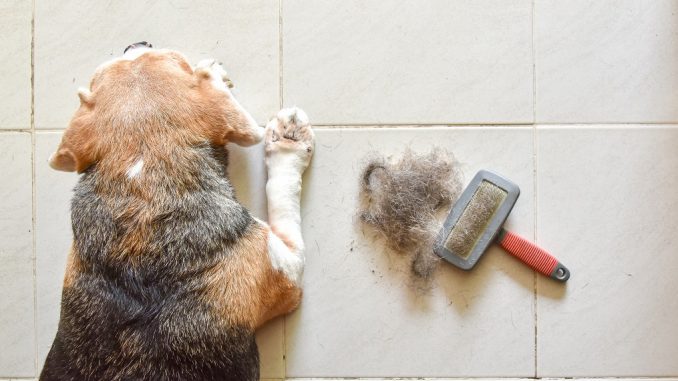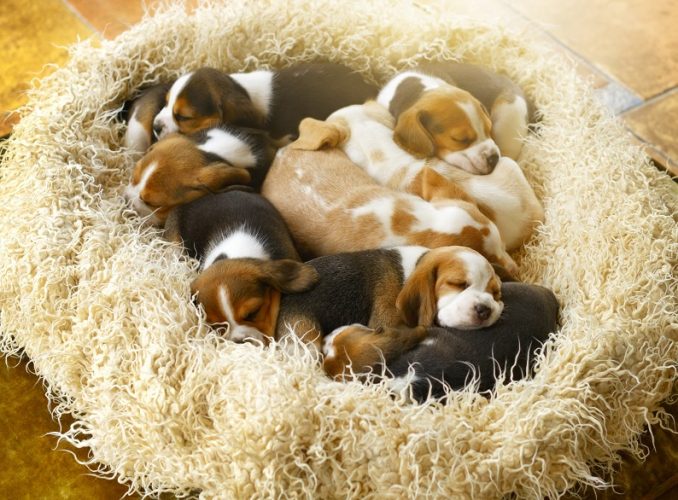
The beagle is a hound (hunting dog) originally bred to have a good sense of smell and tracking instincts.
Today, beagles are still used for hunting small game, but they also make great pets due to their intelligence, friendly nature, and small size.
An average full-grown beagle is 10 to 16 inches tall and weighs 18 to 30 pounds.
Beagles are a popular breed because they are low maintenance, suffer very few health problems, and have longer than average lifespans.
Another reason for their popularity is that beagles are good with other pets and children as they prefer companionship to being left alone. We rank more than a few types of beagles as the best family dogs.
TABLE OF CONTENTS
Beagle Traits and Characteristics
| Breed Type | Hound dog |
| Height | 10 to 16 inches |
| Size | Small |
| Weight | 18 to 30 pounds |
| Lifespan | 12 to 15 years |
| Color Variations | Black, blue, lemon, red, tan, white, bi-colored, black and tan, brown and white, lemon and white, red and white, tri-colored, black, tan and white, black, red and white, |
| Temperament | Intelligent, excitable, gentle, docile, friendly |
| Activity Level | High |
| Shedding | Moderate to high |
| Daily Food Consumption | 840 to 1008 calories a day |
| Known Health issues | Diabetes, obesity, epilepsy, allergies, cherry eye, hypothyroidism, ear infections |
Appearance
Beagles are small, stocky hound dogs with wide, floppy ears that hang down to their chin. Beagles have short coats that are usually tri-colored, and also come in a wide range of colors and markings.
Beagle Height and Weight
Beagles range from 10 to 16 inches tall and weigh 18 to 30 pounds on average.
The American Kennel Club only recognizes two standard beagle sizes: the 13 inch beagle and the 15 inch beagle.
The 13 inch beagle will not grow larger than 13 inches in height at its withers, which is the ridge between its shoulder blades. An adult 13 inch beagle should not exceed 20 pounds for it to be considered a standard 13 inch beagle.
The 15 inch beagles are between 14 and 15 inches in height at its withers. An adult 15 inch beagle weighs 18 to 30 pounds on average.
However, these standard beagle sizes only matter if you plan to have your beagle compete as a show dog. In reality, every size of beagle is just as good as any other.
There is also a pocket beagle that only reaches about 12 to 13 inches in height.
Beagle Colors and Markings
Beagles are usually at least bi-colored like the lemon beagle, while most are tri-colored like the blue tick beagle. The most common beagle color combinations are:
- Black and tan
- Black, red, and white
- Black, tan, and blue tick (the blue is a faded black that has a blue shine)
- Lemon and white (the lemon color is a light brown or tan color)
- Red and white (the red is a dark orange color)
- Tan and white
- Brown, white, and tan
There are also other different beagle colors like a solid black, brown, or white, but those colors are very rare.
Beagles are also known to have markings on their coats. The most common type of marking is a ticked coat which has small freckle-like specks of color. While less common, a beagle might also have the following types of markings:
- Black markings
- Brown markings
- Spotted markings
- Tan markings
- White markings
Beagle Coat
Beagles have a smooth, relatively short double coat. The double coat means beagles have a dense undercoat that keeps them warm, and a top layer that protects them from the rain, sun, and wind.
Because beagles have a double coat, they are moderate to high shedders. Beagles shed the most during the spring and winter.
Beagles shed their lighter summer coats at the beginning of winter to allow their heavier winter coats to come in. At the beginning of spring, beagles shed their winter coats for lighter coats to keep cool during the hotter seasons.
They are not hypoallergenic dogs. People with allergies might want to consider a different breed of dog.
Personality and Temperament
Beagles are sweet, gentle dogs that are very sociable. Beagles prefer to be a part of a family rather than left alone, so they happily make friends with people, other dogs, and even cats.
Because beagles are so docile and friendly, they are not aggressive enough to be good guard dogs. However, they make good watch dogs because they bark loudly and can scare away unwanted visitors.
The personality and temperament of beagles make them great additions to any family.
Beagles are intelligent dogs, which causes them to be stubborn at times. Some owners find that training a beagle is difficult because their dog doesn’t listen to commands. Beagles also get distracted easily by scents.
Taking Care of Your Beagle
Although beagles are fairly low maintenance, there are still things you need to pay attention to in order to take care of them.
Exercise Needs
Beagles are fairly energetic and need to be able to stretch their legs and burn off some energy. Beagles should go on a brisk walk once or twice for 20 to 40 minutes every day.
In addition to walks, beagles love to roam freely in a park or a backyard. Enclosed backyards are suggested because beagles love following scents and might wander off if a backyard isn’t enclosed.
A doggy door is good with an enclosed backyard because the beagle can run around and play safely whenever it desires.
Bathroom Needs
Beagles need to be let out to urinate three to five times a day. They also have a bowel movement at least once a day. Having a doggy door is great because your beagle will be able to go out whenever it desires.
Dietary Needs
A full grown beagle needs a half cup of dry food in the morning and then another half cup at night.
Beagle puppies require twice as much food as full grown beagles, needing two cups of dry food split up between morning and night.
Beagles will overeat and are prone to obesity, so a strict feeding regimen regarding how much food and how often is required. To ensure their overall well-being, it’s essential to provide a well-balanced diet for beagles.
Beagle Grooming
Beagles have fairly low grooming requirements, but pay close attention to shedding, bathing, nail trimming, and ear cleaning.
Shedding

Because beagles have a double coat, they shed all year. Brushing will catch a lot of the loose fur and help spread its natural oils around the coat.
Beagles should normally be brushed at least twice a week.
However, when the seasons are changing and a beagle is losing its coat quickly, they should be brushed daily. It only takes about 15 minutes for a good brushing.
If a beagle is shedding a lot frequently, it might have a skin infection. Check to see if the beagle’s skin is inflamed, harder than normal, or oozing from open sores. If so, take your beagle to the vet.
Bathing
Bathing a beagle should happen once every eight weeks. Don’t bathe a beagle more than once a month, because the beagle’s coat will lose its natural oils which could cause a skin infection or make the shedding worse.
Nail Trimming
A beagle’s nails will grow quickly and require trimming every week or two.
Ear Cleaning
Because beagle ears droop down, they block the ear canal from air flow which creates a place for bacteria to grow. As a result, ear infections often occur in beagles.
Clean the beagle’s ears every two to three weeks.
Beagle Health Issues

Most beagles have a lifespan of 12 to 15 years. Beagles that are taken care of well can possibly live up to 20 years.
However, there are specific health issues that often affect beagles which could cut down their lifespan:
- obesity
- diabetes
- epilepsy
- allergies
- cherry eye
- hypothyroidism
- ear infections
If you are worried that your beagle is suffering from one of these specific health issues, take your dog to the vet immediately.
Beagle Pros and Cons
There are certain traits that make beagles good dogs, and other traits that may make them unsuitable for certain types of owners. These pros and cons will help you decide if a beagle is the right dog for you.
Beagle Pros
- Good Temperament: Beagles are extremely friendly and affectionate dogs that are good with people and other pets.
- Low maintenance: Beagles are easy to groom and keep healthy. They don’t need frequent baths and only need light trimmings every once in a while.
- Longer than average lifespan for dogs: Beagles have fewer health issues compared to other breeds, so they typically live longer than other breeds.
- Amazing scent hounds: Beagles are hound dogs, which means they are bred for hunting. They might be the best kind of hound dog one can own.
Beagle Cons
- Beagles shed a lot: Beagles are moderate to heavy shedders.
- Need a lot of attention: Beagles love to be part of a family and desire attention all the time. If you live by yourself your beagle probably won’t get enough attention and can become destructive.
- Obesity: Beagles will overeat if you give them a chance. Obesity will cause other health problems in beagles and cut down their lifespan.
- Harder to train: Beagles can be stubborn, so they might not listen to your training. They are also easily distracted by different scents. They might start chasing a scent instead of listening to you during training.
- Beagles bark loudly: Beagles will bark for nearly any reason, such as if they’re hungry, bored, lonely, or need to go out. You can cut down on the barking through training, but the problem is their bark is loud.
Should You Get a Beagle?
Beagles are suitable for people who are looking for a hunting dog or a smaller breed for a family.
Beagles have low grooming requirements, so they are also good for people who are busy and don’t have a lot of time to spend on grooming.
For potential owners with smaller backyards, beagles will do just fine with trips to the park for exercise and playtime.
Beagles are not suitable for you if you are busy at work all day and there is no one to spend time with your beagle. Beagles love to dig and if they get bored or frustrated, they will start digging up your back yard or chew up shoes and furniture.
Beagles are also bad for those who are unwilling to spend time training a dog. Beagles are intelligent, but can be distracted easily. Beagle puppies take a little longer to train than other breeds of dogs.
Some beagles shed a high amount, so this breed is not the best for you if you dislike dealing with shedding.
Also beagles bark a lot and bark loudly without proper training. If you don’t have the time to train or the patience for dealing with the barking, beagles are not suitable for you.
How Much Do Beagles Cost?
Beagles typically cost around $550 in the USA.
A beagle puppy can cost $550 up to $6000 based on its pedigree.
Adoption on average costs $50 to $150, but you will need to check your local adoption agency.
Spaying or neutering costs $50 to $300.
Adopting a beagle will also cost $50 to $100 for initial vaccinations.
A “started beagle,” which has started its training for hunting, costs about $800 depending on the trainer.
Other Beagle Costs
After you get your beagle, there will still be more costs involved.
Beagles require $30 to $60 a month on food alone.
Expect to spend $10 to $20 dollars on toys every once in a while. Beagles need a lot of toys when they are young and are teething.
Dog groomers charge $50 to $100 a session. Grooming a beagle should occur at least once a month.
Teeth cleaning costs $300 to $700 each visit. Brushing a beagle’s teeth frequently when they are younger helps avoid this cost and issues with their teeth as they grow older.
A nice dog bed will cost about $50.
Beagle FAQs
- Do beagles protect their owners?
- Can I sleep with my beagle?
- Can beagles be left alone?
- Are beagles smart?
- Are beagles good with kids?
- Are beagles lazy?
- What problems do beagles have?
- Do beagles make good house pets?
- Do beagles like to cuddle?
- Do beagles like water?
- Are beagles good with cats?
- Are beagles good family dogs?
- Are beagles easy to train?
- Do beagles bark a lot?
- Are beagles good dogs?
- Do beagles shed a lot?
- How long do beagles live?
- How big does a beagle get?
- How to Clean Beagle Ears
Other Types of Beagles and Beagle Mixes
Here are some types of beagles and beagle mixes to consider if you are still interested in getting a beagle.








Be the first to comment